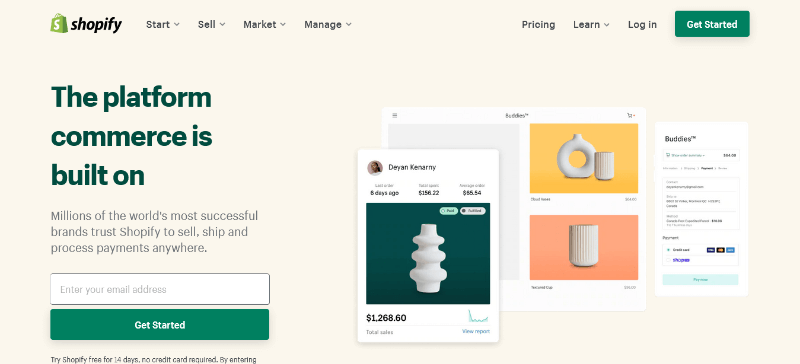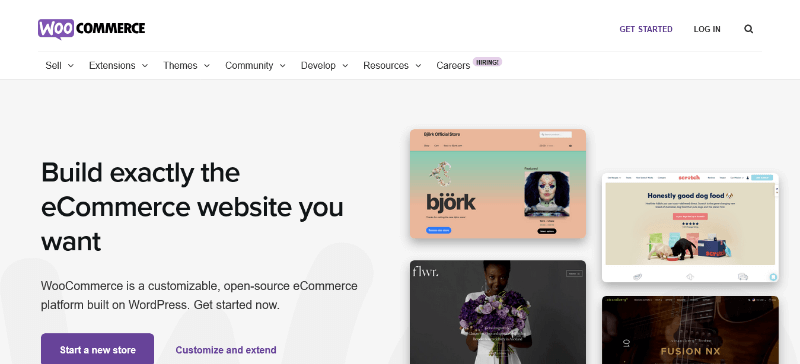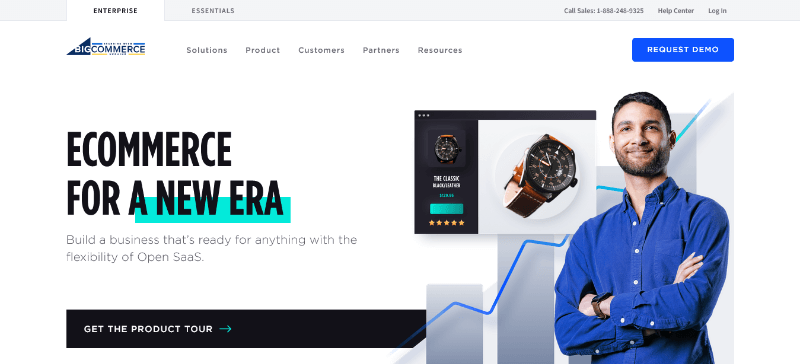Ecommerce platforms are not one size fits all. Each one has its pros and cons. Each one is valuable, but which platform fits best depends on several different variables. The size of the store, company, what marketing and shopping tools are needed, the type of products or services being sold, and others are all factors that play into what eCommerce platform is best for different companies and online shops.
Shopify, WooCommerce, Adobe Magento, OpenCart, and BigCommerce are 5 major e-commerce sites used in the market today. This article compares their features, what makes them stand out, pricing, and their pros and cons. Let’s dive in.
Shopify

Shopify is an e-commerce platform used by more than 90,000 retailers in 100 different countries. and most usage in United States, Germany, Canada, France, New Zealand, Spain, Denmark, Ireland, Belgium, Japan, Netherlands and more. Shopify has been around for more than a decade . The platform offers businesses a professional online storefront that they can build themselves. Shopify has inventory and warehouse controls that allow sorting products into collections or smart bundles. It also has built-in blogging and email marketing systems.
Shopify offers a customizable POS system and a payment solution to accept credit cards. Small retail businesses and businesses mainly use Shopify in the marketing and advertising industry.
What Makes Shopify Stand Out
Shopify stands out as a hosted e-commerce service provider. It takes care of the domain name, hosting, and security (SSL) certificates. There is no external software to install, manage, or update. The backups and security are all taken care of through the e-commerce platform.
Shopify makes it simple to add SEO information to an online store via product descriptions and titles for images, products, and pages. Shopify has an extensive app store too. It offers plugins and extensions for all kinds of functions, and there are several for SEO.
The platform has a streamlined checkout system and offers many payment options for customers. They provide a seamless shipping process too. This helps companies keep a good reputation with customers. Shopify has partnerships with USPS, DHL Express, UPS, and Canada Post, saving business owners from having to source their shipping courier.
Another huge option for business owners that helps Shopify stand out is their Sustainability Fund and Social Impact initiatives. The platform says they are building for the long term which means “investing in our planet, our communities, and our people.” They do this by “choosing renewable energy, reducing and offsetting our carbon emissions, and enabling an equitable and sustainable future by building products and programs to support our team and merchants.”
Price
The price depends on many variables. Monthly price packages, free or paid themes, and the different plugins all determine how much a business will pay for a website.
Shopify offers five packages with price tiers that correspond with the tools the e-commerce platform offers. The Basic package starts at $29 a month. It includes a POS, unlimited products, and fraud analysis tools. The $79 Professional package adds more features and increases storage space.
The Unlimited package is $179 a month and provides businesses with unlimited storage space, advanced analytics, and real-time shipping updates. For high-volume businesses, It have a Plus package for $2000 a month. This offers businesses a lot of features such as advanced security features and extensive options for selling in multiple currencies.
Shopify Lite offers one of the cheapest ways of selling online. The cost is $9 a month and offers unlimited products, but it does not offer all of the features of having a fully functional online store.
Shopify has more than 100 payment gateway options for customers, but they take a percentage of every credit card sale. The fees differ depending on if the sale was made in person or online. The ratio also depends on what tier of the business’s payment plan is currently using.
The e-commerce platform offers more than 70 free and paid themes to choose from. Premium themes start at $140 each. It is a one-time purchase, but there are many free themes to choose from too. Each theme is designed to help businesses sell, so they look professional and are easy to customize. Shopify also has a huge app store with a plethora of free and paid apps to add to a shop’s page.
Pros
- Shopify offers tools to manage products, accept payments, easy category organization, and so much more.
- The POS system is customizable to better serve customers on the sales floor.
- They offer customizable themes that are ready to use immediately.
- There is no coding knowledge necessary to get started.
- Shopify has built-in email marketing software, multi-channel selling, and analytics.
- A huge app store for a customizable experience.
- Shopify includes hosting, security, and 24/7 support.
- Built-in features allow businesses to sell on other channels like Amazon, Facebook, eBay, and Pinterest
Cons
- Shopify has its own application framework, so it can be difficult to customize by code.
- Some features are not intuitive and can make customizability difficult.
- Apps can be expensive and makes it easy to wrack up a big bill.
- There is a blog function, but it is not the best option for websites that want content integration.
WooCommerce Platform

WooCommerce started in 2008 and is an open-source commerce solution built on WordPress. It began as a team of three founders from Norway, the United Kingdom, and South Africa. Now the all-remote company has more than 150 team members in 32 countries. The core platform is free and open-source. It allows options for selling from anywhere in the world.
WooCommerce is a much more technical platform than Shopify. It requires more legwork like sourcing web hosting and security separately. There are several ways to do this. One example is Bluehost. They have a dedicated WooCommerce plan that includes a auto-install, a free domain name, and an SSL certificate.
What Makes WooCommerce Stand Out
WooCommerce is built for eCommerce and is integrated with WordPress with its extensive range of eCommerce plugins. WooCommerce and Shopify both provide 3rd party apps, themes, and plugins. Also, have more than 100 payment gateways for customers and has shipping options available.
Also, It offers an entry theme called Storefront that is fully responsive on mobile devices. But, it allows for unlimited amounts of customization, so the way a website looks will depend on how much time an owner is willing to put into the design.
WooCommerce does allow businesses to sell on Amazon, eBay, Instagram, and Facebook. Selling on Facebook is free to install, but integrating the other selling options will cost $79. Also, you can update a multi-vendor marketplace by adding external plugins ( Dokan, YITH Vendor, WC Vendors, and more ).
Price
WooCommerce is a free ecommerce application. Prices can vary depending on the plugins added to the site. One bonus of WooCommerce is that it does not charge its transaction fees when businesses use a third-party payment gateway. Bank charges will still apply.
WooCommerce appeals to sellers selling a large volume of products and choosing their merchant account.
Pros
- WooCommerce is an open-source platform that offers limitless customization.
- It allows for flexibility and scalability.
- It is free to install and offers many free plugins :more than 50,000 themes and plugins to choose from.
Cons
- WooCommerce is not beginner-friendly. Shopify does not require any coding knowledge, but WooCommerce will be a better fit for someone who has some coding knowledge and can really customize a website.
- Most of the security will fall into the hands of the business. They will need to have an SSL certificate, configure site security plugins, two-factor authentication, PCI compliant, and some other things to protect the site.
Adobe’s Magento

Magento is best for large enterprises. They provide a customizable platform for companies to manage and optimize. It was originally developed by Varien as an open-source e-commerce content management solution.
Magento’s sites are set up to generate SEO-friendly URLs, a Google site map, and customized meta tags. Data is gathered to segment customers and personalize their shopping experience using targeted ads, suggestions, and coupons.
Magento Open Source is available for developers and tech-savvy users, but it requires knowledge of coding languages to be successful using it. The paid versions offer extensive features including business intelligence, order management, and an extensions marketplace.
Small and mid-level enterprises can use the paid version of Magento, but it is best used for large companies because of its high price point.
What Makes Magento Stand Out
Magento’s ecommerce optimization tools are extensive and allow users to build highly targeted pages. This platform gives businesses the flexibility to sell direct-to-consumer or B2B.
They provide more than 4,000 extensions that are “out-of-the-box” which means they are ready to use immediately. Magento also has performant APIs and a robust commerce backend.
Magento offers users options on how to build out their sites. Options include building a coupled, responsive website or using Magento’s headless architecture to manage web applications, integrate with a CMS, or build custom digital touchpoints.
Price
The paid version of Magento is not cheap. Even Magento Open Source could run businesses up to $15,000 a year. This is why Magento is only recommended to large-grossing firms. Magento Commerce and Commerce Cloud are both dependent on the business’s gross annual revenue. If sales skyrocket, the price will be higher, but Magento Commerce usually runs businesses around $22,000 a year and Magento Commerce Cloud hits around $40,000 a year. None of these prices include domain names, web developers, or extensions.
Magento is unsuitable for running a non-e-commerce site or for new businesses just starting to sell online. Unless the company handles large orders and makes a large amount of money, it is not worth the investment. WooCommerce and OpenSource are both recommended as lower-cost alternatives.
A large company will find Magento’s scalability and advanced features excellent for managing their business.
Pros
- Magento streamlines online orders and payments.
- Bulk catalog changes can be done using .csv files saving time and enhancing productivity.
- Magento is compatible with Quickbooks.
- The platform is highly customizable and has many options for extensions.
- Templates are available too.
- Allows for simple subscriptions and sales from the customer’s perspective.
Cons
- Magento can be complicated to develop and code. It is not made for people with no coding experience.
- The cache must be manually cleared for the shopping cart and technical glitches happen.
- Programs can be slow or buggy.
- The platform offers many tools, but that makes it difficult to train new employees on how it works.
- Email marketing tools are not easily customizable.
- User reviews say the reporting tools are not great and certain administration workflows are not intuitive.
OpenCart

OpenCart is an open-source e-commerce platform focused on worldwide e-trading. Tens of thousands of businesses use the platform to sell online products. They offer search engine-friendly features along with an aesthetically pleasing interface.
The platform is free and runs on plugins. They offer more than 10,000 options for extensions to help make the site customizable and user-friendly.
OpenCart’s main users are small businesses in the retail and internet industries.
What Makes OpenCart Stand Out
OpenCart offers e-commerce shops a way to look professional and gain sales online. It is an open-source platform making it easily scalable. Extensions are available to customize the site. Users can make money and contribute to OpenCart forums by building modules and selling them to other OpenCart users.
The platform is good for building websites for retail businesses with unlimited product categories. Data management, large queries that take a long time to load, and users without previous developer experience are not recommended for this platform.
Price
OpenCart is free to download and use to build an online store. However, extensions will need to be downloaded since it is open-source software. Those can cost money and can add up quickly. Many free extensions and themes are available though.
Setting up an online store will not be completely free, no matter how it is set up. Users may also need to pay a developer to design the online version of their shop. That could take a considerable amount of money. Costs such as site hosting, security, and other standard charges are unavoidable when doing business.
Pros
- OpenCart is a highly customizable platform for websites.
- The site offers support, analytics, payment platforms, and abandoned cart recovery emails.
- Extensions are available to customize websites and make them more user-friendly.
- Customizable themes are available to give sites their own unique look.
- OpenCart supports an unlimited amount of categories for products, which are easy to upload.
- It is free.
Cons
- OpenCart may be free to download, but it is unlikely that users will get away without having to pay for a few plugins to optimize their website.
- User reviews say new versions often come with a lot of bugs, and support may be lacking.
- User reviews also say returns are made difficult through the platform.
- OpenCart is constantly creating new versions and updates are frequent.
- Developer skills are highly recommended to use OpenCart.
- The way the platform works makes deleting data critical or the system slows down. This can be confusing and time-consuming if users do not have previous experience with this type of software.
BigCommerce

BigCommerce is a SaaS (Software as a Service) platform like Shopify. Their website says they are one of the leading cloud e-commerce platforms for growing businesses. Users can customize their own storefront, configure products, manage payments, generate traffic, and optimize conversion.
BigCommerce powers more than 60,000 brands. There are options to use HTML, CSS, and Javascript or users can use a drag-and-drop building option. This e-commerce site is known for its security features. They use the Google Cloud Platform to offer multiple layers of security to users.
They offer B2B, wholesale, multi-channel selling, and international selling options. The SaaS system works with WordPress. BigCommerce is headless commerce, so edits can be made to the backend of the site without it affecting the customer experience.
The primary users of BigCommerce are small businesses in the retail industry.
What Makes BigCommerce Stand Out
BigCommerce is known for its robust security. They offer users protection with multiple layers of security through the Google Cloud Platform.
The e-commerce platform offers users without coding experience a way to get their business up off the ground. They use a visual creation option with drag-and-drop features. This makes it easy for anyone to use
Price
BigCommerce has 4 pricing options. Starting at $29.95 per month for the standard version. The Plus version is $79.95, and the Pro is $299.95. A free trial of BigCommerce and a customizable price option is also available.
Pros
- BigCommerce offers users one month free to try them out.
- They have 0% transaction fees. Competitors take 2% or more.
- BigCommerce has high-rated security.
- They have an efficient one-page checkout.
- 24/7 support is available
- Sell with Amazon, eBay, Facebook, Instagram, Google Shopping, and more.
- No coding experience is required. BigCommerce works with a drag-and-drop visual editing tool to help users build a beautiful online store.
- Flexible APIs.
Cons
- Editing metadata can be difficult. It can only be edited by the API user that originally created the data.
- Not suitable for multi-site companies.
- Email marketing is lacking
- The checkout page is lagging behind Shopify and WooCommerce when it comes to efficiency.
Recap
Shopify and BigCommerce are SaaS platforms that allow users without prior coding knowledge the chance to customize and style their e-commerce websites. When these two eCommerce platforms are compared to each other, Shopify and BigCommerce are similar in price. They both offer affordable monthly packages. Both platforms provide high-quality security features too.
WooCommerce and OpenCart are open-source platforms. They require more coding knowledge than BigCommerce or Shopify, but they offer more customizations. WooCommerce and OpenCart require the user to purchase the domain and security separately whereas Shopify includes it. WooCommerce and OpenCart are great, affordable platforms for small or medium-sized businesses to set up an e-commerce website.
Magento is best for large companies with a large budget and a team of website developers. The programs are expensive, require a lot of coding knowledge before using, and take a long time to set up compared to the other sites discussed in this article. Users say OpenCart’s open-source code is easier to understand than Magento’s. According to users, Shopify offers simple layouts that are easy to use and simpler to set up, and look better than Magento’s.
When choosing what platform to use for a business, there are many variables to keep in mind. How much revenue is the company bringing in, what kind of coding knowledge does the team have, and what does the site need to do are all good questions for companies to answer before deciding on a platform for their website.
Small to medium-sized businesses that do not want to deal with coding or do not have employees with website development skills will do best using Shopify or BigCommerce. They are affordable, user-friendly, and offer options for website customization.
Small to medium-sized businesses that have access to someone with coding skills will do best with WooCommerce or OpenCart. Both options offer incredible amounts of customizability. Both are affordable. Options for paid plugins can help businesses scale faster, but those costs can add up quickly.
A large business with a lot of money and a team of developers may opt into trying Adobe’s Magento. The program offers infinite customizations and is great for companies with high order volumes.
All five of these top e-commerce platforms have benefits to offer businesses. Hopefully, this article is helpful when comparing and contrasting these options for building an e-commerce website.
Sources
- https://athemeart.com/blog/what-is-e_commerce-business/
- https://athemeart.com/blog/what-is-shopify/
- https://www.trustradius.com/products/shopify/reviews?qs=pros-and-cons
- https://athemeart.com/blog/what-is-woocommerce/
- https://www.trustradius.com/products/woocommerce/reviews
- https://www.trustradius.com/products/magento-commerce/reviews
- https://business.adobe.com/products/magento/competitors.html
- https://www.trustradius.com/products/magento-open-source/reviews
- https://www.websitebuilderexpert.com/ecommerce-website-builders/comparisons/woocommerce-vs-shopify/


